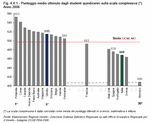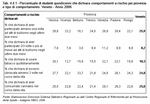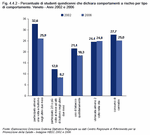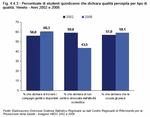Measuring school children's cognitive ability means evaluating the knowledge and intellect of young people based on a series of abilities which are deemed necessary to play an active and informed role in society and to set out along the road of life-long learning where every life experience provides an input.
It is clear that if we want to speak about education nowadays, though, we cannot simply limit ourselves to cognitive learning; we absolutely must consider education as a network: a complex mechanism which is closely linked to a system of types of behaviour and social relationships.
This is why it is of fundamental importance to evaluate behaviour and quality as perceived by the children themselves, as the users and active and integrated members of the schooling network; this is also true for their parents, both as instigators and guardians of their children's educations, as they are instrumental themselves (directly or indirectly) within the school system.
 Cognitive levels
Cognitive levels
Employment opportunities depend greatly on a good education, so that in a competitive society like our own, it has become ever more necessary to improve the level of basic skills learned. The PISA (Programme for International Student Assessment) survey
(Note 1) enables us to verify to what extent fifteen-year-olds have acquired specific skills which are essential to participating actively in society.
It is the most valuable study to evaluate teaching effectiveness available today, also because it enables comparison between countries, within the countries, between geographical areas, between kinds of schools, and between students with varied social and family backgrounds.
PISA 2006
(Note 2) reveals that students in Veneto achieved satisfactory results, whereas Italy as a whole performed below the OECD average in all areas, revealing an inferior scientific and cultural competitiveness in Italian youth. If we take into account the average of the scores obtained for the three subjects that make up the test-maths, reading and science-in Veneto the cognitive level is 515 points, which places it eighth in the ranking of OECD countries, quite a step in front of its European competitors such as Germany (505 points), France (493 points) and Spain (476 points).
The country with the highest general cognitive level is Finland, with an average overall score of 553, whereas the last in of the 30 OECD countries is Mexico with 409 points
(Figure 4.4.1).
If we standardise all of the scores on a scale of 0 to 100 based on the results attained from the highest (Finland = 100) to the lowest values (Mexico = 0), the fifteen year-olds in Veneto got a score of 73.6. This is undoubtedly an impressive performance seeing as fifteen year-olds in the north-east of Italy got 70.4, those in the OECD got 60.9 and Italian fifteen-year-olds overall got just 41.4.
In general, boys are more skilled than girls in mathematics and the sciences, the opposite is true when it comes to reading. There is quite a difference between the different types of schools: lyceums recorded the highest scores in all fields, distancing themselves greatly from the other types of schools.
The family's social status has a stronger influence on a child's learning level than any other social or demographic category. As social inequalities increase, equality in the education system also tends to be less homogeneous; the relationship between status and school has in Veneto, and in Italy as well, less of an influence than in the average OECD country, as can be seen in the "Abilities of fifteen year-old students in Veneto. Veneto Regional OECD-PISA 2006 Report" by Veneto's Regional Education Office.
Furthermore, if we look at the influence the family's social status has on cognitive ability, linked with type of school, the only impact it has is really in the professional schools, and even then, not in all subjects.
 Behaviour
Behaviour
The debate on the importance and influence, be it positive or negative, children's behaviour and attitudes have on their ability to make their way through the education network has been widely touched upon, and is still relevant today.
The latest school reform and the evaluation of behaviour have recently been the subject of much discussion, which has highlighted the strong correlation between a pupil's lifestyle and their educational output. Regrettable incidents, such as bullying and abuse of substances leading to addiction have been in the public eye recently; a school system which accompanies pupils in their development and personal growth cannot but take into account antisocial behaviour, with the aim of helping young people develop awareness of the importance of respect for oneself and for others.
Data from a study on the state of health and on the lifestyles of school-aged young people carried out by the Regional Centre of Reference for the Promotion of Health in Veneto, shows that in 2006 in Veneto, on average, more than one fifteen-year-old in four claimed to have taken part in incidents of bullying in the two months preceding the interview. 8.2% claimed to have taken part in incidents of bullying towards their schoolmates two or more times in the previous two months.
In the different provinces, bullying is more or less common; in Belluno it is less of an occurrence (16.1% at least once and 3% two/three times or more), whereas in the province of Venezia it happens more often (28.9% and 11.2%)
(Table 4.4.1).
A large share of fifteen-year-olds, 24.8%, claimed to have got drunk at least twice in their lifetime, and 18.3% admitted smoking on a daily basis; contrary to what we have seen on bullying, in the province of Belluno there is a greater likelihood of young people drinking alcohol.
Within the region, differences between the provinces, although slight, show that Padova, Venezia and Verona are the most high-risk provinces, whereas in Vicenza this type of anti-social behaviour is less apparent.
In the province of Venezia, interestingly, almost 30% of fifteen-year-olds claimed to have tried cannabis in their lifetime; in Veneto overall this percentage is 25%.
As a whole, these are worrying figures which are cause for reflection on the part of all those who are actively involved in educating and training young people.
We can give a small sigh of relief, however, if we compare the figures to four years previously: as a matter of fact, almost all the percentages are decreasing
(Figure 4.4.2).
Compared to 2002, random episodes of bullying in Veneto decreased by almost 7 percentage points, whereas more recurrent episodes decreased by around 4 points. Fewer fifteen-year-olds claim to smoke on a daily basis; this figure decreased from 21.4% in 2002 to 18.3% in 2006, and the percentage of those using cannabis went down by almost three percentage points.
The only percentage to increase slightly was the share of fifteen-year-olds claiming to have got drunk at least twice in their lifetime; this was up 0.4 percentage points on 2002.
 Quality as perceived by school children and their parents
Quality as perceived by school children and their parents
In order to ensure that the school career of young people is enriching and stimulating from an educational point of view, both the students' perception of the quality of the system, as its users, and their families' perception as well, seeing as they play a fundamental role in the growth of these young people, are of extreme importance. On the one hand, it is necessary to help develop not only intellectual and cultural growth in these young people, but also a more open system of communication of relationships and stimuli, aiding the transfer from the system of relationships to that of motivation. On the other hand, there is the need to create an educational partnership between the school and the family, based on shared values and on a proactive collaboration from both parts in terms of respecting children's abilities.
All of this stems from the fact that the main aim of the whole school system is to act as support to families, a continual pathway to learning and personal growth which aims to bring up young people who are not only well-educated, but also free and responsible individuals ready to face whatever future decisions life brings. Putting this into practice means creating strong foundations to cut down on drop-outs, marginalisation and drifting amongst young people
(Table 4.4.2).
Going back to the data from the 2006 study on the state of health and on the lifestyles of school-aged young people carried out by the Regional Centre of Reference for the Promotion of Health in Veneto, 15-year-old students in Veneto tend to have contrasting opinions on their school environment and on the stimuli that this implies and requires. This is cause for much thought; these variables play a central role in the extent to which school is considered a "training ground for life" where pupils learn to cope with life and with work.
Six out of ten pupils see their schoolmates as kind and helpful, and 59.1% say that they like their educational career; in contrast to this, however, more than 56% of pupils feel stressed out by school.
In brief, the province where pupils appreciate their school environment the most is Vicenza, and Verona the least. However, Vicenza also appears to be the province in which fifteen-year-olds claim to feel most stressed out by school, as attested by 61.9% of all students.
Compared to 2002, fifteen-year-olds in Veneto in 2006 seem to tend to enjoy school and their relationships with their peers more: the share of those saying that they liked school very much rose by more than two percentage points, while the percentage of those who said they thought their schoolmates were kind and helpful increased by over four points. On the other hand, however, school-related stress increased enormously: from 41% of school children feeling stressed out in 2002, this rose right up to 56.5% in 2006
(Figure 4.4.3).
Families had more positive remarks to make about their children's schooling. According to data from the 2006 PISA survey, parents appear to be slightly more critical regarding their children's results at school, whereas they are more likely to see their children's overall and global education in a more positive light
(Table 4.4.3).
On a scale of 0 to 100, where 0 indicates strong disagreement and 100 strong agreement, parents of fifteen- year-olds in Veneto gave a positive evaluation of their children's overall education, with a score of 72.5. To the innate quality of available schooling they gave 66.9, to the information received about their children's progress and to the school environment they gave 65.6, and to their children's school results they gave 64.8. All of the scores were higher than 60 out of 100, which indicates that parents feel that quality in schools is rather good, or at least sufficient.
This is important data which highlights a willingness to take on new challenges, as the education network is also formed through the coming together of the schooling system and the families involved. We are going through a period of transition and great change in society; we are now at a crucial turning point in the development of relationships between the school and the family, where it is ever more important to create, maintain and consolidate an environment of mutual trust and collaboration.











